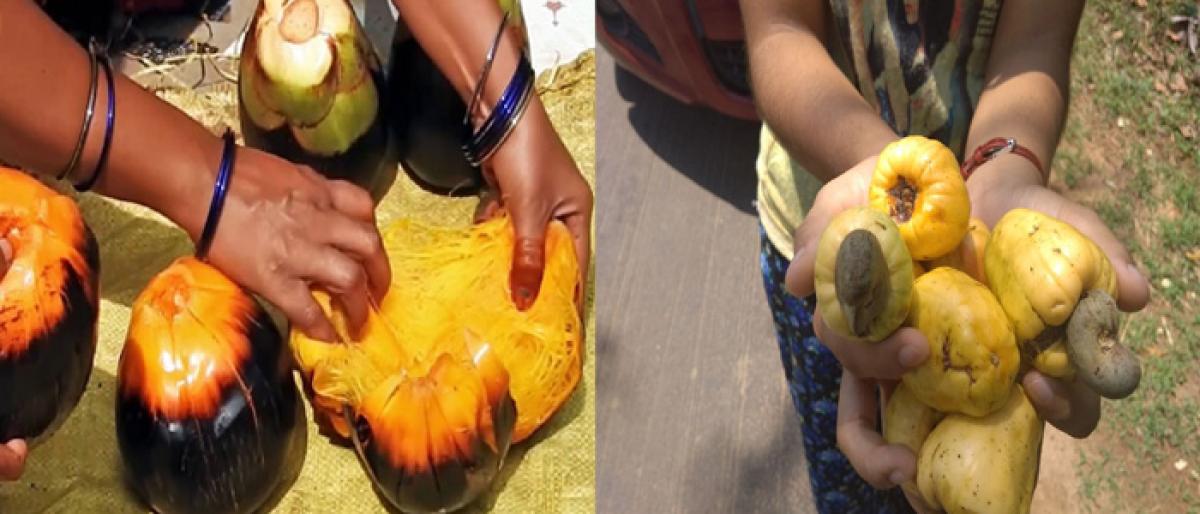Live
- MyVoice: Views of our readers 24th April 2024
- Nasa to overhaul mission MSR – here’s why it must
- ‘Military strength, capabilities necessary to prevent wars’
- Youths indifference to voting is unhealthy for democracy
- Actress Rithika and models inaugurate Sutraa Lifestyle Exhibition
- Loud campaign
- Faculty students celebrated english literature day in Government Degree College
- Huge fire accident.. Shops of street vendors burnt in the fire
- Pawan Kalyan promises to protect the coastal area from sea erosion
- EC Transfers Two Senior IPS Officers in AP ahead of Elections
Just In

Summers are not just about mangoes; even as people await mangoes to arrive, various fruits and vegetables that are seasonal, some of which grow in the wild, and some in backyards and gardens find their way into homes.
Summers are not just about mangoes; even as people await mangoes to arrive, various fruits and vegetables that are seasonal, some of which grow in the wild, and some in backyards and gardens find their way into homes.
In Telangana districts, closer to Hyderabad, soon after the arrival of tamarind that grows in abundance on trees, Morri Pandlu, the sweet and mildly sour, tiny and delicate fruits hand plucked from trees make their way into the city.
Known to be coolant and extremely beneficial to body these tiny fruits are brought in cane baskets by tribal women and are addictive when eaten just like that. The seed when broken open has what we call Chironji, the almond flavoured tiny nuts that are used in Indian cooking.
Seema Chintakaya, also known as Manila Mango in the West and Madras Thorn in India for some random reason, is also sparingly available in April, the peak season being March. These too are eaten raw even though I read somewhere that it is cut and fried to be eaten with rice and in meat dishes. This used to be poor man’s substitute to mango and cashew.
Then enters the Chinta Chiguru – the tender tamarind leaves. By virtue of being tangy, these tender tiny leaves are used in every possible preparation in Telugu homes; Pappu, Pachadi, Rasam, Pulihara, as curry in conjunction with lentils, in mutton, fish…it’s as if there is nothing that isn’t prepared with it.
Yet another common sight across two states of AP and Telangana during the season are Thaati Munjalu – Ice Apples taken from the Palm fruit that are sold by dozens along the highways and local markets.
Apparently, these too when not so tender are cut into pieces and made into a curry using grated coconut – we are obsessed with cooking everything and anything I guess. In the next stage, when the fruit ripens and drops down to the ground, through a long and laborious process, the delicious juice is extracted from the Thaati Pandlu, mixed with rice flour, and small flattened patties of this mix are steamed.
The initiated ones would know them as ‘Kudumulu’ – the mildly sweet snack of Andhra region. Also, these ripe palm fruits are burnt over traditional coal-fired stoves and the cooked juice is extremely delicious. The modern stoves can be used for the purpose too. The same juice is used to make what is known as Thaati Bellam (Palm Jaggery). Getting your hands on these in the city is a jackpot.
A similar all-purpose tree produce is jackfruit. While every part of this fruit is useful, I particularly like Panasa Pottu koora (made using the skin). Other recipes made using jackfruit, especially in coastal Andhra are Panasa Ginjala Thalimpu (using the seeds), pulao, and fish marinated in green masala steamed in the leaf – Panasaaku.
The North Coastal Andhra is known for its cashew plantations. The ripe cashew fruit, which is also eaten raw, can be made into a pulusu, that was enticingly showcased recently on social media by a writer friend from Visakhapatnam. The raw cashew that sticks to the fruit can also be cooked – it is cut into pieces after removing the skin to be made into a curry.
From the forests and rocky terrains of Rayalaseema come the dark and sweet Ullirikayalu and the thorny Balichi Kayalu, that are very tasty, especially after ripening them by keeping them in the special grass. This season also brings in the country cucumber used to make chutney and cooked in masala like the Bagara Baingan.
The unique seasonal specials of the region also include the leafy veggie Nela Thangidi Aaku (this spreads on the ground and hence is known by the name) used to make chutney, and also, fried using ground spices.
Health experts vouch for the seasonally available fruits and vegetables. Revisiting them will not bring in goodness but will also bring back the lost flavour to our food cycle. And Telugu land with its diverse landscapes has an abundance to give.

© 2024 Hyderabad Media House Limited/The Hans India. All rights reserved. Powered by hocalwire.com







